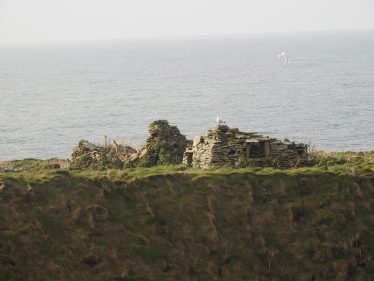Bishops Island or Illaun an Espig Gortaig.
Location and Geology.
Bishop’s Island lies around two miles south west of Kilkee opposite the town land of Fuathach. It is a unique sea stack that was separated from the mainland some time in the last thousand years. A sea stack is a geological landform consisting of a steep ,often vertical column of rock in the sea near the coast. At some point in the last thousand years Bishop’s Island was connected to the mainland. The constant battering and erosion caused

Bishops island in background.Photo by Robert Brown.
by the sea weakened cracks in the headland ,causing them to collapse forming the free-standing sea stack. It measures 180m x 90m and is 65meters high.
Monastic Settlement.

Bishop’s Island. Photo by Robert Brown.
What makes this site unique is that there are the remains of a 6th century monastic settlement consisting of a church, a clochaun (beehive hut) and the ruins of up to four other buildings. it is believed to have been founded by Saint Senan. The archaeology was described by W.Wakeman in ‘Archaeologia Hibernica ‘ as “Two very ancient dry stone buildings and two plain pillars are plainly visible at no great distance from the opposite cliff. The oratory is about 5.5 x 3.6 meters and the walls almost a meter thick, with a linteled east window and south door. West from it lies a circular clochaun ,35 meters in circumference, with a domed roof built in stages externally, and a linteled door to the east.” The remains of the church indicate it was a dry stone church of Gallarus type shaped like an upturned boat because of its sloping side walls with stones cut on every side that fit perfectly together. The smoothly finished outside facings follow the slant of the wall. The church was small ,with an area of only 9m²,designed to only accommodate the small resident isolated community. The clochaun was constructed in a similar style to the church.
Tradition.

Bishop’s Island. Photo by Robert Brown.
There is a tradition in the area that there was a small burying place on the island in which was buried any monks that died on the island. A local legend exists which relates to the name Bishop’s Island.A bishop ,apparently attempting to escape the Irish Famine, brought food to the island, he became trapped on the sea stack and starved to death. The sea stack was subsequently named Oilean an Easpoig Gortaigh, the island of the hungry bishop. Another local name in English is the Stingy Bishop’s Island. It is also said it was the last monastic settlement that Saint Senan visited before he died, as on his way back to Scattery Island from Bishop’s Island he feel ill and died at the convent of Cill-na-gCaileach i.e. the Church of the Nuns in the town-land of the same name.
Bird Sanctuary.
The island is designated a Special Protection Area as it is an important nesting ground for sea birds and an important roosting area at night for Barnacle Geese when they are here in winter.Locals use the flight of the Barnacle Geese onshore as a forecast for extremely bad weather.





Comments about this page
Rob
The Office of Public Works is the body resposible for the up keep of these buildings. The Parks and Wildlife Service also has an input as it is part of Kilkee Reefs SAC (Special Area of Conservation). I have written to both some time back but did not even get an acknowledgement. I complained because the growth of some plant species was overwhelming the structures on the isalnd.Would you make a complaint in the new year? The more comlaints they get the better.
John Williams
Add a comment about this page